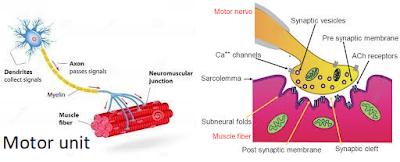Neuromuscular Junction
- It is a specialized area where the motor nerve end on the skeletal muscle fiber.
- This junction between the neurons (autonomic) and the cardiac and smooth muscle is not well developed, hence impulse transmission across it is diffuse.
The neuromuscular junction consists of the following:
Pre junctional membrane:
It is the terminal part of the motor nerve containing
vesicles packed with neurotransmitter Acetylcholine. The motor nerve breaks
into several branches and forms the terminal button which fits into the
depression on the muscle membrane.
Synaptic cleft or gutter:
It is a potential space between the terminal button and the
muscle membrane. There is not structural continuity but the cleft establishes
the functional continuity due to the presence of neurotransmitter Acetylcholine
Motor end plate:
It is the muscle membrane containing Acetylcholine
receptors. It form post junctional membrane. The membrane has numerous folds
called subneural cleft. The folding of the membrane increases the surface area
to accommodate large number of Acetylcholine receptors.
 |
Motor
unit & Neuromuscular Junction |
Transmission of impulse across the Neuromuscular Junction
Impulse arrives at the nerve terminal
▼
Opening of Voltage Gated Calcium channel
▼
Influx of Calcium in to the nerve terminal
▼
Calcium helps in docking of the vesicles containing Ach to
the inner side of the presynaptic terminal
▼
Release of Acetylcholine into the synaptic cleft by
Exocytosis
▼
Acetylcholine binds to the Ligand Gated Sodium channel on
the motor end plate
▼
Opening of Ligand Gated Sodium channel
▼
Influx of Sodium into the muscle
▼
Generation of End Plate Potential
▼
Summation of End Plate Potential cause generation of Action
Potential
Action Potential reaches T tubules and cause release of
Calcium ions from the Sarcoplasmic reticulum
▼
Calcium ion binds to the contractile protein
▼
Initiation of muscle contraction
*After the action, the ACh in the synaptic cleft is degraded
by enzyme cholinesterase
 |
| Just for referrence |
End Plate Potential (EPP)
- It is the potential generated at the motor end plate during neuromuscular transmission of impule. It is graded and non-propagated. Summation of End Plate Potential reaches the firing level and an Action Potential is produced.
Miniature End Plate Potential
- During rest, small quantity of acetylcholine is released from the presynaptic terminal. This alters the membrane permeability of motor end plate. It is incapable of producing an Action Potential.
Neuromuscular blocking agents
Succinycholine:
- It binds to the Acetylcholine receptors present on the motor end plate and prevents transmission of impule by competitive binding.
Botulinum toxin:
- It is produced by bacteria Clostridium botulinum. It prevents the release of Acetylcholine from the presynaptic terminal.
D-tubocurare:
- Like the Succinlycholine, D-tubocurare also blocks the acetylcholine receptros on the motor end plate by competitive binding.
Physostigmine and neostigmine:
- They destroy the cholinesterase enzyme in the synaptic cleft. This causes prolonged action of Acetlycholine and sustained depolarisation of motor end plate.
Organophosphorus compound (Insecticies):
- Mechanism of action is similar to Physostigmine, that is it produces sustained depolarisation of motor end plate
Applied Physiology
Myasthenia Gravis
It is an autoimmune disorder where there is destruction of
Acetylcholine receptors which are present on the motor end plate due to
circulating antibodies. This prevents the neuromuscular transmission.
The symptoms are
- Weakness and fatigue of extraocular muscles
- Difficulty in seech
- In advanced stage – Respiratory failure
The condition can be managed by administering
anticholineesterase or cholinesterase inhibitor such as Physostigmine and
Neostigmine.
These drugs delay the destruction of Acetlycholine at the
synaptic cleft. Acetylcholine being in contact with the receptor for a longer
time cause depolarisation of motor end plate.
Lambert-Eaton Syndrome
It is also an autoimmune disorder of neuromuscular junction where the transmission of impulse is hampered. In this condition the antibodies damage the Calcium channels at the nerve terminal causing no relase of neurotransmitter. The condition is associated with weakness.
No comments:
Post a Comment